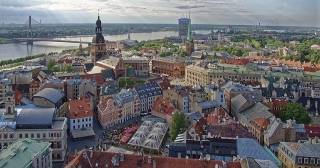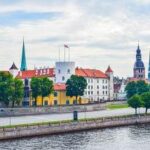Holidays in Latvia

Latvia’s chequered history is reflected in its customs and holidays. Its location by the sea, between East and West, has always made the country interesting for both sides. In the Middle Ages it fell into the hands of German crusaders. Later it belonged first to the Russian Tsarist Empire and then to the Soviet Union.
The Latvian national feeling has asserted itself despite the many influences and feeds not insignificantly from the music. With the peaceful so-called “Singing Revolution” of the three Baltic states, the breakaway from the Soviet regime and independence were achieved in 1990. Folk music and singing are an integral part of everyday life in Latvia, which guests can experience during patriotic holidays as well as at the many traditional name day celebrations.
Overview
New Year’s Day – January 1
Karif Friday – two days before Easter Sunday
Easter Sunday – Sunday after the first full moon in spring
Easter Monday – one day after Easter Sunday
Labor Day – on May 1
Independence Day – on May 4
Midsummer (“Līgo”) Day – on June 23
John’s Day (“Jāni”)- on June 24
National Day/Independence Day 1991 – on November 18
1st Christmas Day – on December 25
2nd Christmas Day – on December 26
Worth knowing about selected holidays
Easter
In Latvian Easter, celebrated for many centuries, pagan and Christian customs have entered into a delightful union. Even in pre-Christian times, the awakening of nature was joyfully welcomed on March 21 at the spring solstice – when, for the first time again, the day is longer than the night.
According to ancient Latvian tradition, one is supposed to wash one’s face in a stream flowing eastward. According to tradition, this brings health and beauty.
The “Easter swing” is supposed to help you get through the summer without too many mosquito bites, because the summer mosquito plague is a problem in Latvia. If you burn the swing in time to prevent it from being used by Easter witches, cattle and crops also thrive especially well … If boys jokingly push the girls, they are rewarded with socks, biscuits or eggs, according to old custom.
Līgo and Jāni – Midsummer and St. John’s Day
These are the most joyous and exuberant hours of the year, when on the night of the summer solstice, June 23-24, all of Latvia is on its feet celebrating the longest day. Traditionally, everyone who can somehow manage it leaves the city and enjoys the night in the forest or by a lake. A special barley beer provides the necessary atmosphere, and people fortify themselves with St. John’s cheese with caraway seeds and other snacks before bonfires are lit at nightfall. Because it is the time of the “White Nights”, it does not get really dark, and the night is celebrated with dancing and singing. Beforehand, wildflowers were picked, branches were cut and wreaths of oak leaves and flowers were tied, animals and houses were decorated.
If you don’t want to risk bad luck for the coming year, don’t go to sleep before sunrise. If you are a visitor and have the chance to join in the celebration of a Latvian Midsummer Night, you won’t forget it in a hurry.
National Day
On November 18, 1918, the independent Republic of Latvia was proclaimed in Riga in what is now the National Theatre. After the October Revolution and World War 1, the opportunity had arisen for the political intelligentsia to make the dream of an independent state come true. It lasted until June 17, 1940, after which Latvia was occupied by the Red Army and annexed by the Soviet Union.
After that, it would take over 50 year for the country to regain its independence in 1991.











